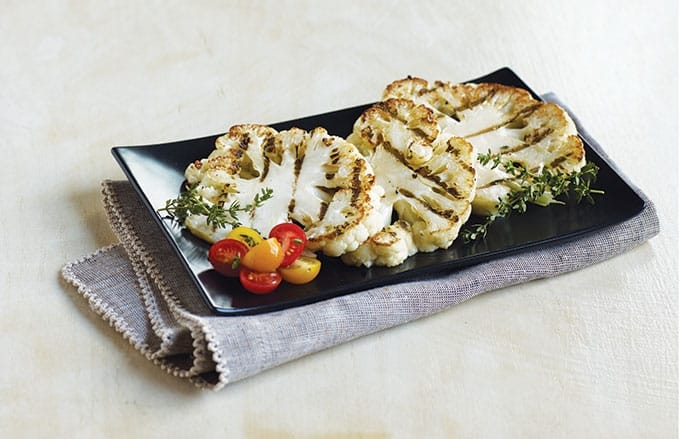
Long a standard bearer for white vegetables, cauliflower is a good source of fiber and vitamin K, and is an excellent source of vitamin C and folate. Cultivation of mutant cauliflower strains has broadened cauliflower’s color palette, as well as its nutrition profile. Carotenoids are responsible for orange cauliflower’s color, and it contains more than 300 micrograms of beta carotene per 100 grams. Broccoflower, a variety of green cauliflower, gets its vibrant hue from chloroplasts. It has twice the vitamin C of white, but half the beta-carotene of orange. Anthocyanins give purple cauliflower its vibrant color, but do not alter its vitamin content.
Cauliflower is rich in phytochemicals and antioxidants. Glucosinolates contribute to cauliflower’s distinct aroma and flavor. Some research shows that cruciferous vegetables, like cauliflower, Brussels sprouts and broccoli, may help reduce risk of certain cancers, namely prostate cancer.
While its family origins date back more than 2,000 years, cauliflower — the edible, immature flower head of a cabbage relative — became popular in Europe during the 1500s. Cauliflower is a staple around the country, but most commercial domestic cauliflower is cultivated in California, where it enjoys a nearly year-long growing season.
The recent explosion in cauliflower varieties means a greater choice of colorful options for the table, including orange, purple, green and Romanesco — a variety of green cauliflower with spiky florets that form a conical head. Their flavor undertones differ slightly, but all still taste like cauliflower.
Breaking raw cauliflower curd (compact clusters of buds) into small florets adds crunch to salads. Steaming or microwaving preserves nutrients while brightening color and mellowing flavor. Cauliflower cooked with the lid on or cooled while covered can develop off-flavors and aromas. To bring out cauliflower’s sweetness, drizzle florets with olive oil and roast in the oven until lightly browned. Some chefs recommend covering the pan with foil for the first 10 minutes to allow the florets to steam. Cooked, pureed cauliflower incorporates into soups, casseroles and mashed potatoes, often undetected.
Italian cuisine often pairs cauliflower with pasta or features it solo as a side dish baked with a breadcrumb topping. It is a standard in Indian cuisine alongside potatoes (gobi aloo); onion, tomato and coconut (gobi korma); or spicy sauce (gobi masala).
Cauliflower can be temperamental in the kitchen — delicious if properly prepared, but unpleasant when stored incorrectly. Cauliflower needs to be stored in a cold, dry environment, and it tolerates only a short stay in the refrigerator.
Plastic bags of washed, ready-to-eat florets are convenient for food service. Look for brightly colored firm curd without blemishes. Unopened bags should be refrigerated at 34 to 38 degrees Fahrenheit for up to two weeks or until the “use by” date; finish open bags within three days. For the freshest cauliflower, choose heads with crisp, tight leaves, and avoid bruised or dry heads. Keep fresh cauliflower away from ethylene-producing fruits such as apples and pears —they cause discoloration.
Frozen cauliflower is extremely soft when cooked, so it’s best suited for soups and purees. Place the frozen florets in a wire basket and cook in a pot for four to eight minutes until tender. Leftover cooked cauliflower should be refrigerated and eaten within three days.
You Won’t Believe it’s Cauliflower Pizza Crust
Developed by Jamie Van Eaton
Ingredients
1 cup cooked, riced cauliflower*
1 egg
1 cup part-skim mozzarella cheese, shredded
1/2 tsp. dried fennel
1 tsp. dried oregano
2 tsp. dried parsley
Directions
- Preheat oven to 450°F.
- Spray a cookie sheet with non-stick spray. Combine cauliflower, egg and mozzarella. Press evenly on the pan. Sprinkle with fennel, oregano and parsley.
- Bake for 12 to 15 minutes. Remove from the oven.
- Top with your favorie toppings. Place under a broiler at high heat until cheese is melted.
Cooking Tip
How to rice cauliflower: After cauliflower is cooked and slightly cooled, shred cauliflower with a cheese grater or potato ricer.
Nutritional Info
(For crust only)
Serves 8
Serving size: 1/8 slice
Calories: 60
Total fat: 3.5g; Saturated fat: 2g; Trans fat: 0g
Cholesterol: 30mg; Sodium: 11mg
Carbohydrate: 3g; Fiber: 1g; Sugar: 1g
Protein: 5g
Gobi Aloo (Indian Cauliflower and Potatoes)
Developed by Tamar Genger
Ingredients
2 Tbsp. ginger-garlic paste (see below for instructions)
1 Tbsp. ground coriander
1/4 tsp. turmeric
1 cup water, divided
2 Tbsp. peanut oil
1 large Serrano pepper, split down the middle
1 tsp. cumin seeds
1 small head cauliflower, cut into small florets
1 russet potato, peeled and cut into 1/2-inch cubes
Kosher salt
2 Tbsp. freshly minced cilantro leaves, for garnish
Directions
- Mix ginger-garlic paste, coriander, turmeric and 1/2 cup water to make a wet masala (spice mix) and set aside.
- In a large pot, warm oil over medium-high heat until shimmering, but not smoking. Add Serrano pepper; wait 30 seconds, then add cumin seeds and cook until they stop spluttering.
- Carefully add wet masala and cook until paste thickens and slightly deepens in color, about 2 minutes.
- Add cauliflower and potatoes, stirring to coat vegetables with masala. Season with salt to taste and add 1/2 cup water.
- Cover and cook over medium heat for 10 minutes.
- Remove lid, stir and cook until cauliflower and potatoes are tender, about 5 minutes.
- Garnish with cilantro and serve.
Nutritional Info
Serves 4
Serving size: 1 cup
Calories: 160
Total fat: 9g; Saturated fat: 1.5g: Trans fat: 0g
Cholesterol: 0mg; Sodium 30mg
Carbohydrate: 20g: Fiber: 3g; Sugar: 2g
Protein: 3g
Garlic-Ginger Paste
Ingredients
1/2 cup garlic cloves, whole
1/2 cup fresh ginger, peeled and cut into 1/2-inch slices
1/4 cup canola oil
Directions
- Combine ingredients in a mini-food processor until it forms a semi-smooth past. Meaure amount needed for recipe and save extra in a small glass jar.
- Will keep refrigerated for 2 to 3 weeks.
Nutritional Info
Serving size: 1 tablespoon
Calories: 30
Total fat: 3g; Saturated fat: 0g; Trans fat: 0g
Cholesterol: 0mg; Sodium: 0mg
Carbohydrate: 2g; Fiber: 0g; Sugar: 0g
Protein: 0g



